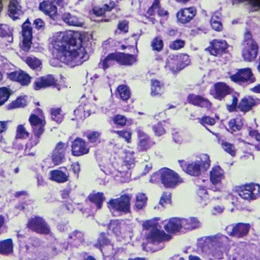Osteosarcoma
What is osteosarcoma?
Cancer is made of changed cells that grow out of control. The changed (abnormal) cells often grow to form a lump or mass called a tumor. Cancer cells can also grow into (invade) nearby areas. And they can spread to other parts of the body. This is called metastasis.
Osteosarcoma is the most common type of bone cancer that often develops in the osteoblast cells that form new bone. The bone the cancer cells make is not as strong as normal bone.
Osteosarcoma is not a common cancer. About 1,000 new cases of osteosarcoma are reported each year in the U.S. It happens most often in children, teens, and young adults. And it happens slightly more often in males than in females.
Osteosarcoma most often starts in the ends of long bones around the knee. Long bones include legs and arms. Other sites for osteosarcoma include the upper leg (thighbone), the lower leg, or the upper arm bone. But it can start in any bone in the body, including those in the pelvis, shoulder, and skull.
Osteosarcoma may grow into nearby tissues, such as tendons or muscles. It may also spread, or metastasize, through the bloodstream to other organs or bones in the body.
What causes osteosarcoma?
The exact cause of osteosarcoma is not known. But it is believed to be due to DNA changes (mutations) inside bone cells. These are either inherited or acquired after birth.
Who is at risk for osteosarcoma?
A risk factor is anything that may increase your chance of having a disease. The exact cause of someone’s cancer may not be known. But risk factors can make it more likely for a person to have cancer. Some risk factors may not be in your control. But others may be things you can change.
Risk factors for osteosarcoma include:
-
Teenage growth spurts
-
Being tall for a specific age
-
Having treatment with radiation for another cancer, especially at a young age or with high doses of radiation
-
Some noncancer (benign) bone diseases
-
Having treatment with specific types of chemotherapy for another cancer
Genetics also plays a role in risk. Risk factors also include certain rare, inherited disorders, such as:
-
Li-Fraumeni syndrome. A rare family predisposition to multiple types of cancers (such as soft tissue sarcomas, breast cancer, brain tumors, osteosarcoma, and others) caused by a mutation in a gene—often the p53 tumor-suppressor gene—that normally curbs the development of cancer.
-
Rothmund-Thomson syndrome. A rare inherited syndrome that includes skeletal problems, rashes, short stature, and an increased risk of developing osteosarcoma. It is caused by an abnormality in the REQL4 gene.
-
Hereditary retinoblastoma. A cancer of the eye that often happens in children younger than 4 years old.
Talk with your healthcare provider about your risk factors for osteosarcoma and what you can do about them.
What are the symptoms of osteosarcoma?
The following are the most common symptoms for osteosarcoma. But each person may have slightly different symptoms. Symptoms may include:
-
Pain in the affected bone or joint that gets worse over time
-
Swelling and stiffness around the affected site
-
Increased pain with activity or lifting
-
A broken bone with no clear cause
-
Limping
-
Decreased movement of the affected limb
The symptoms of osteosarcoma are a lot like the symptoms for other health conditions. Always talk with your healthcare provider for a diagnosis.
How is osteosarcoma diagnosed?
In addition to a complete health history and physical exam, diagnostic procedures for osteosarcoma may include various tests.
You may have imaging tests of the tumor and sites of possible metastasis. You may have one or more of these:
-
X-ray. A diagnostic test that uses beams of small amounts of radiation to make images of internal tissues, bones, and organs on film.
-
Bone scans. A nuclear imaging method to evaluate any degenerative or arthritic changes in the joints. It can also find bone diseases and tumors. And it can find the cause of bone pain or inflammation. It uses a small amount of radioactive tracer injected into a vein.
-
MRI. This procedure uses a combination of powerful magnets, radiofrequencies, and a computer to make detailed images of organs and structures in the body. This test is done to better define a mass seen on an X-ray and to look for any nearby spread of tumors. A contrast medium is given in a vein before the scan to make the images clearer.
-
CT scan. This imaging test uses X-rays taken from different angles and a computer to make detailed 3-D images of the body. A CT scan shows details of the bones, muscles, fat, and organs. It can be used to measure the size of the tumor. A contrast medium may be given before the scan to make the images clearer. It can be given in a vein or by a pill or liquid to swallow.
-
Positron emission tomography (PET) scan. A small amount of radioactive sugar (glucose) is injected into the bloodstream. Tissues that use the glucose more than normal tissues (such as tumors) can be found by a scanning machine. PET scans can be used to find small tumors that have spread. It is often combined with a CT scan called a PET-CT scan.
You may have other tests, such as:
-
Complete blood count. This test measures the size, number, and maturity of different blood cells in a specific volume of blood.
-
Other blood tests. These might include tests to check for certain substances in your blood.
-
Biopsy of the tumor. Small pieces of the tumor, called tissue samples, are removed (with a needle or during surgery) from the body. The samples are then checked under a microscope by a pathologist to see if cancer or other abnormal cells are present.
After a diagnosis of osteosarcoma, you’ll likely have other tests. These help your healthcare providers learn more about the cancer. They’ll show how much and how far the cancer has spread (metastasized) in your body. A stage grouping is then assigned.
How is osteosarcoma staged?
The stage of a cancer tells your healthcare provider how much and how far it has spread in your body. The stage of a cancer is one of the most important things to know when deciding how to treat it.
In the staging system most often used, the stage groupings have a value of 1 to 3. They are written as Roman numerals I, II, and III. In another system, there's also a stage 4 (IV). The higher the number, the more advanced the cancer is. Letters and numbers can be used after the Roman numeral to give more details.
Staging for osteosarcoma also takes into account the grade of the cancer. This is a measure of how much the cancer cells look like normal cells. A grade of 1 or 2 is used. Grade 1 looks most like normal cells and tends to grow and spread slower than grade 2. This may be called low grade. Grade 2 is high grade. These cells look very different from normal cells. They tend to grow and spread faster than low-grade cancer cells.
Your healthcare provider will talk with you about what your cancer stage means for your treatment. Ask any questions or talk about your concerns.
How is osteosarcoma treated?
Treatment will depend on your symptoms, age, and general health. It will also depend on how bad the condition is.
Treatment may include:
-
Surgery to remove the tumor. This is the main treatment for most people.
-
Chemotherapy to kill cancer cells anywhere in the body
-
Radiation therapy to kill cancer cells and shrink tumors. It might be used after surgery to kill any cancer cells that may be left behind.
-
Rehabilitation, including physical and occupational therapy, and psychosocial adapting
-
Supportive care for the side effects of treatment
Many people, particularly those with higher grade tumors, will receive a combination of treatments. Some types of treatment may later affect fertility. If this side effect is permanent, it might cause infertility. This means you may not be able to have children. Both men and women can be affected. Ask your healthcare team about fertility preservation choices before starting treatment.
Talk with your healthcare providers about your treatment choices Make a list of questions. Think about the benefits and possible side effects of each choice. Discuss your concerns with your healthcare provider before making a decision.
How do I manage osteosarcoma?
Managing a cancer diagnosis can be a life-changing event for both the person and the family. Each person decides how to adapt to the diagnosis. If physically able, some people find it helpful to keep their prediagnosis daily routine, such as spending time with family and friends, going to work, and taking part in trips and other activities. Other people find the diagnosis life-changing and decide to rethink how they spend their time. An important factor in your decision will be the long-term outlook, or prognosis, for the osteosarcoma.
The prognosis for osteosarcoma depends on:
-
The extent of the disease
-
The size and location of the tumor
-
The pathologic grade of the cancer
-
The tumor's response to treatment
-
Your age and overall health
-
Your tolerance of specific medicines, procedures, or therapies
-
The type of treatment used
-
Your treatment preferences
As with any cancer, prognosis and long-term survival can vary greatly from person to person. Every person is unique and treatment is structured around your needs. Prompt medical care and aggressive therapy are important for the best outcomes. Continuous follow-up care is vital for a person diagnosed with osteosarcoma. Side effects of radiation and chemotherapy, including second cancers, can happen in survivors.
In addition to the physical impact of a cancer diagnosis and treatment, managing possible issues linked to the cancer, such as emotional, financial, and sometimes legal, can be overwhelming. Ask your healthcare team for help if you are concerned about issues in any of these areas. They will have community resources that may be able to help you and your family.





